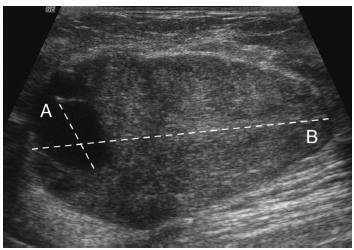-
Original Article04-01-2016
Cysts within Otherwise Probably Benign Solid Breast Masses and the Risk of Malignancy
Revista Brasileira de Ginecologia e Obstetrícia. 2016;38(4):170-176
Abstract
Original ArticleCysts within Otherwise Probably Benign Solid Breast Masses and the Risk of Malignancy
Revista Brasileira de Ginecologia e Obstetrícia. 2016;38(4):170-176
Views224Abstract
Objective
The objective of this study is to assess whether the largest cyst diameter is useful for BI-RADS ultrasonography classification of predominantly solid breast masses with an oval shape, circumscribed margins, and largest axis parallel to the skin, which, except for the cystic component, would be likely classified as benign.
Methods
This study received approval from the local institutional review board. From March 2009 to August 2014, we prospectively biopsied 170 breast masses from 164 women. We grouped the largest cyst and mass diameters according to histopathological diagnoses. We used Student's t-test, linear regression, and the area under the receiver operating characteristic curve (AUC) for statistical assessment.
Results
Histopathological examination revealed 143 (84%) benign and 27 (16%) malignant masses. The mean largest mass diameter was larger among malignant (mean standard deviation, 34.1 16.6 mm) than benign masses (24.7 16.7 mm) (P < 0.008). The mean largest cyst diameter was also larger among malignant (9.9 7.1 mm) than benign masses (4.6 3.6 mm) (P < 0.001). Agreement between measurements of the largest mass and cyst diameters was low (R2 = 0.26). AUC for the largest cyst diameter (0.78) was similar to the AUC for the largest mass diameter (0.69) ( p = 0.2). A largest cyst diameter < 3, 3 to < 11, and 11 mm had a positive predictive value of 0, 15, and 52%, respectively.
Conclusion
A largest cystic component < 3 mm identified within breast masses that show favorable characteristics may be considered clinically inconsequential in ultrasonography characterization. Conversely, masses with a largest cystic component 3 mm should be classified as BI-RADS-US category 4.
Key-words Breast cancerbreast imaging reporting and data systembreast sonographycircumscribed massescomplex massesSee more


